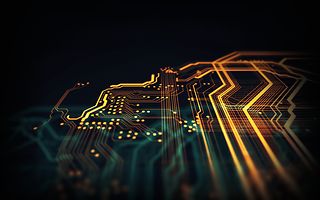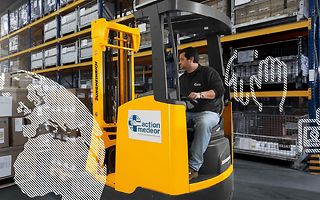Lithium-ion technology
Structure:
- A lithium-ion battery consists of several individual cells combined and contacted in "stacks".
- Within the lithium-ion cell, a membrane separates a positive and a negative electrode.
- No liquid electrolytic is required.
- The individual cells are always monitored electronically by a battery management system (BMS).
- A connection to the truck controller optimizes the entire system.
Operation:
- During charging with a high frequency charger, lithium ions migrate from the positive to the negative electrode.
- Depending on the design, the battery can be fully charged within an hour.
- During discharging, the lithium ions migrate back, releasing electrical energy as they do so.
- During braking and lowering, energy is very effectively fed back into the battery.
Hybrid technology
Structure:
- In hybrid technology, combustion engine trucks can be "electrified" with additional components.
- An electric motor and a battery are added to the drive train.
Operation:
- The energy required for travelling and lifting can be derived either from the combustion engine or the electric motor.
- Depending on the operating point, a control unit determines how much energy comes from which source.
- It is also possible depending on the system design to drive electrically only for a limited time.
- During braking and lowering, energy can be fed back into the batteries through the electric motor.
Fuel cell technology
Structure:
- A fuel cell system consists of:
- Hydrogen tank
- Fuel cell
- Lithium-ion energy store
- Controller
- Pumps, valves, cooler
- Additional weight
- a stationary hydrogen tank station
- All of the structural elements of this "portable power plant" require no more space than a lead battery.
Operation:
- The fuel cell generates the electrical energy required by the electrical drives in the truck in
an electrochemical reaction of hydrogen and oxygen. - The hydrogen required for this reaction is provided under high pressure in a gas tank.
The oxygen is simply taken from the air. - The only "exhaust" is pure water and heat. The electric energy is temporarily stored by a lithium-ion battery and is then available immediately for the drives.
Extremely reliable energy storage systems
New energy storage systems such as lithium-ion cells or fuel cells must be tested and approved by the vehicle manufacturer. CE conformity represents the manufacturer's guarantee that the product meets all safety standards. This always applies to the entire system, consisting of the truck and energy storage system.
Especially in the segment of lithium-ion technology, we ensure the highest safety standards through consistent internal development and manufacturing of the most important components:
- The defined cell chemistry is exactly coordinated to and tested for the requirements of truck operation. It provides the optimum solution in terms
of service life, performance and safety. - The battery management system developed and manufactured by us internally ensures continuous monitoring of cells and immediate shut-down in case of an accident or similar incident.
Fuelling/charging in daily operation
| | Complete fuelling/
charging | Range | Suitability for
3-shift operation |
| Diesel | 3 min. | About 20 h | Suitable without restrictions |
| Hybrid | 3 min. | About 22 h | Suitable without restrictions |
| Fuel cell | 3 min. | About 6-8 h | Suitable with intervening refuelling |
| Lithium-ion battery | 60 min. (20 min. für 50% charge) | About 8-16 h | Suitable with booster charge |
| Lead battery | 360-720 min. | About 6-12 h | Suitable with battery change |




